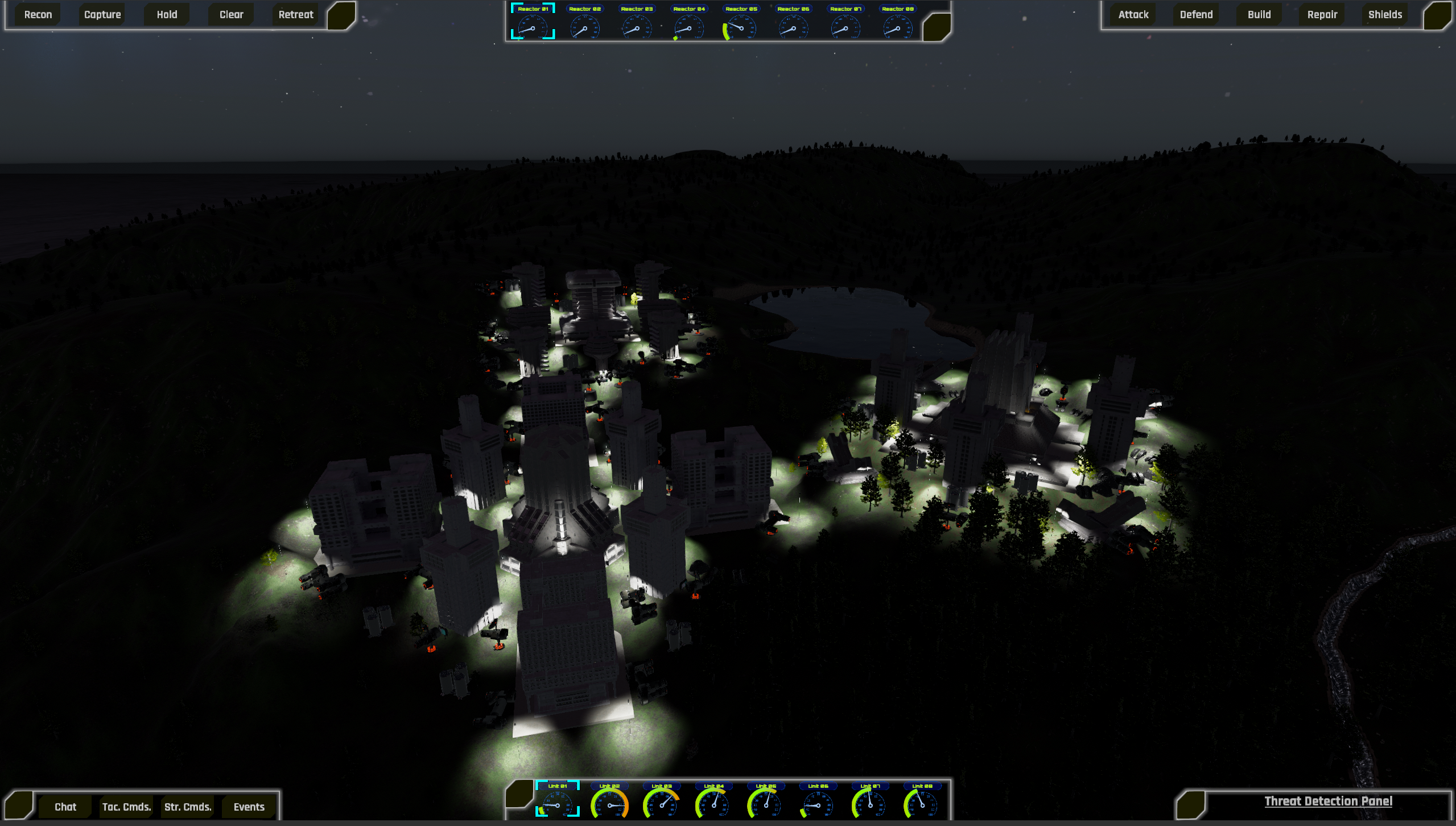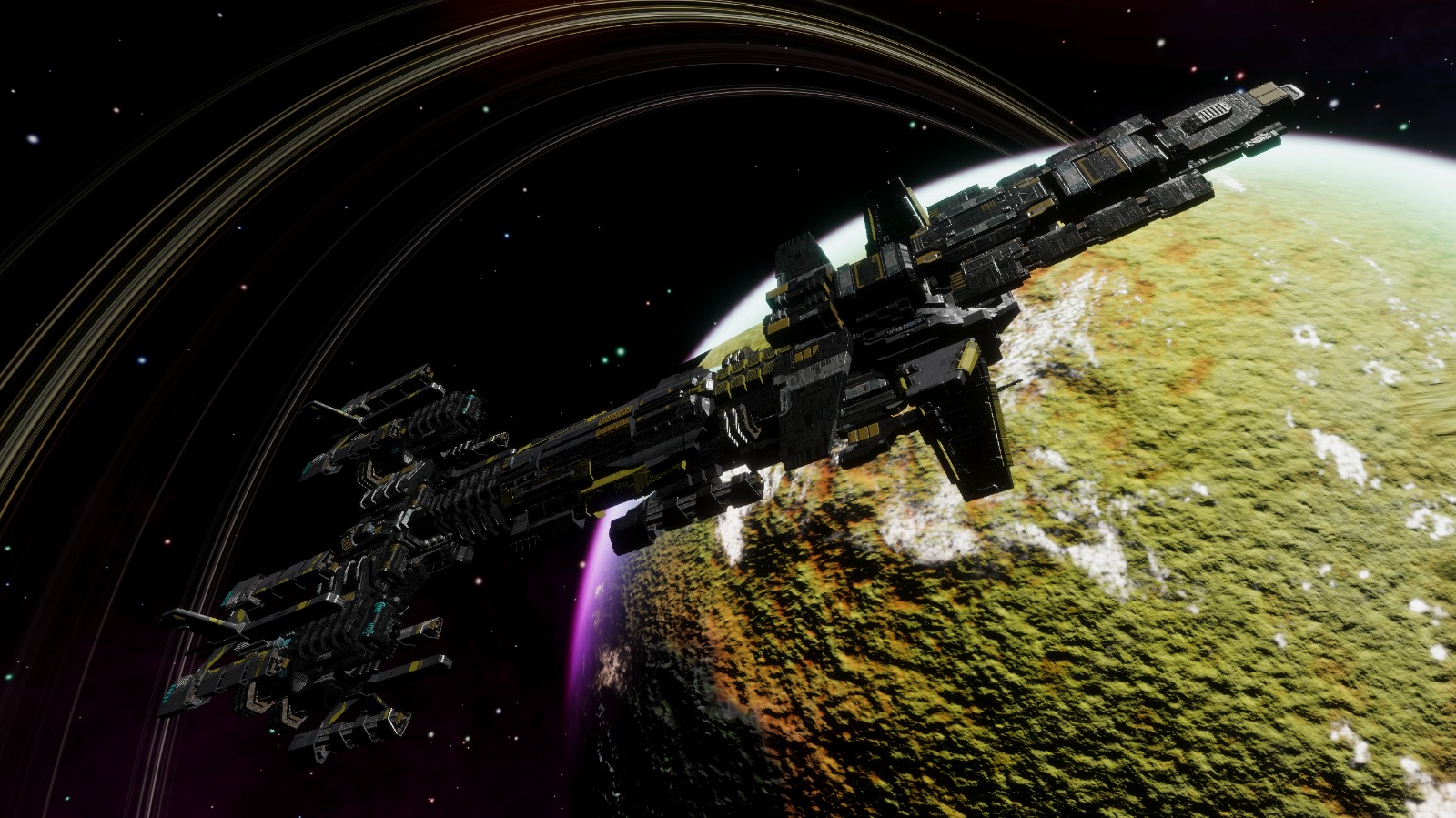
The Resource Transport Network is fundamental to the generation and transfer of energy, units, and communications between all Installations and Outposts
The Resource Transport Network, or R.T.N., is arguably the single most critical piece of technology that is employed in any campaign. At its heart is a highly resilient mesh topology that is constructed from carbon nanotubes that provide reasonably secure, underground connectivity between all facilities and outposts that are built during a campaign. It handles secure communication between these units, in addition to all forms of energy distribution. This includes energy required for all operational needs, as well as the distribution of the matter streams associated with the transport of mobile units either being constructed or being moved between transporter outposts.
Every static unit is equipped with a specific number of RTN interfaces, allowing it to connect with the RTN mesh and provide additional routing capacity and resilience. Whilst the number of interfaces in a given unit cannot be increased, the bandwidth and range of its connections can, through research of the units effectiveness design principle.
The effective maximum range between two static units is the greater range of their respective RTN interfaces. The effective bandwidth of the connection is the lower rating of the respective nodes. For this reason, it is important to try and balance the capabilities of all static units as much as possible to avoid creating unintended bottlenecks and host spots.
If a static unit is destroyed, all upstream facilities and outposts that no longer have at least one path back to a command centre will no longer be able to receive orders, contribute to overall production capacity or be changed in any way. Any upstream stockpile facilities will be unable to unload their stored units and are high value targets for hostile takeover until such time as they can be reconnected to a command centre.
If a static unit has been converted to an opposing team, then in addition to the above, it will attempt to convert any other static unit that is still attached. In this instance, it pays to have static units equipped with a combat computer as it will detect the infiltration and immediately disconnect the interface to the offending unit.
For the above reasons, it is prudent to employ military facilities at strategic locations across your RTN. What they lack in active contributions when compared to rectors or production facilities, they make up for with ultra-hard connections and extreme defensive/offensive capability. They are exceptionally hard to kill or subvert and, with their higher-than-average interface count, they provide considerable resilience to the RTN.
As stated above, each interface has a finite bandwidth which must be shared between energy distribution to maintain operational readiness of downstream units and the transfer of matter streams for constructing or transporting mobile units. Should capacity become contended, a priority quality of service can be configured to allow control of the preference given to the two energy streams. The configuration is RTN wide and will affect all connected nodes when it is changed.
A given static unit will attempt to find its closest neighbour to fulfil any production or energy request. Preference is given to units closest to the source, with any surplus energy being routed to downstream nodes. If a unit is unable to completely fulfil its energy demands, it will search for more distant energy sources (reactors, wind farms or generators), to address the shortfall.
In the event it is unable to fully satisfy the demand, it can either partially or fully switch to internal power if it has been equipped with local power plants and fuel cells. Typically, these are configured to have enough capacity to support an operational load for a few minutes to ensure defences and weapons systems can remain online. One main line RTN energy has been restored, the fuel cells will automatically be replenished, subject to the availability of surplus power not being needed by downstream nodes.
RTN and internal power are also used to refuel and repair any garrisoned mobile units if the static unit has been equipped with refuelling pods.

The energy required to build and power all units comes, primarily, in the form of geothermal power that is extracted by Reactor Installations but can be supplemented by wind energy by way of Windfarm Outposts. Careful placement of both reactors and wind farms is essential for efficient power generation. Placing these units in poor locations will result in much reduced output which, in turn, will require more units to be constructed to meet any given demand.
To obtain data on the relative energy levels of your immediate environment, simply equip your deployment or recon unit with an Environmental Scanner. When activated, it will analyse the parameters of the environment within its range and transmit the data to your starship in orbit where it is used to overlay heatmaps on the terrain maps. This provides a visual representation of both hot and cold spots for energy reserves and will give a good indication on high locations of high strategic value.
Once the power has been extracted (or generated via a Generator Outpost), it must be transferred to other static units for consumption. Each static unit will come with a defined number of RTN interfaces based on its function. While the bandwidth and range of these interfaces can be greatly improved through research, the overall quantity cannot. The greater of the ranges of two units' RTN interfaces effectively defines the maximum separation distance between them, assuming they both have at least one unused interface available, of course.
An important consideration when planning the topology of your RTN is that power demand is effectively daisy-chained so the RTN interfaces of units closest to the reactors will be under much higher load than those further away.
Typically, this isn't an issue for normal operational loads as a unit will only draw around 20% of its peak load to keep core day-to-day services running. However, if a unit is attacked and powers up its weapons and shields, the load on the RTN will increase significantly. You only need a few units under attack that are connected in sequence to the same reactor and you are likely to exceed the available bandwidth which will result in rolling brownouts
As stated above, the interface bandwidth is finite. Under ambient loads, there is typically sufficient capacity for both operational energy required to power downstream units, and matter stream energy that is transferred when units are produced or when they use the transporter outposts to cross larger distances more quickly and securely.
If the topology has been poorly planned and too many units are drawing operational energy because they are under attack, for example, then there may not be sufficient capacity to accommodate unit matter energy as well.
To account for this situation, the RTN as a whole, provides a prioritisation quality of service which allows the command team to specify the relative ratio of operational to matter energy. By default, this is a 50:50 split, but if you are undergoing heavy mobile unit expansion or transporting large numbers of units, you may opt to amend this ratio in favour of matter stream energy. This will typically force the static units to fall back to local power generation (assuming you equipped them with sufficient power plants and fuel cells). Their fuel cells will auto refill once RTN energy is available.

Energy to construct static units comes via short life, geothermal nano cables extruded by the deployment payload. They draw sufficient power to construct and charge the unit but are then rendered inert.
For mobile units, the appropriate outpost will make the build request on its nearest, least loaded Production Installation. This, in turn will request a power allocation from its nearest Reactor Installation which, when ready, is transferred across the RTN to the Production Installation. Once the build is complete, the unit is converted back to a matter stream and sent to the requesting outpost (or a Stockpile Installation) for final materialisation.
Every weapon and component fitted to a given unit will have an ambient and active power rating. The former will be drawn regardless, the latter will be drawn while the component or weapon is active. There will be a corresponding heat output to go with these values, which, as with the mass, cannot exceed the operational maximum for that unit. If a weapon, component or unit becomes heavily damaged, its power and heat draw will increase in line with a reduction in its performance.
When the unit is first constructed, all fitted fuel cells will be 100% filled. For static units, this should always remain the case unless the unit experiences brown outs or loses its RTN connection to a reactor. The more fuel cells you equip a unit with, the longer it can operate on its own power, but at the expense of reducing available slots for other components such as shield generators or stealth tech.
When mobile units run low on fuel, if they are fitted with combat computers, they will suspend their current task and make their way back to the nearest suitable outpost fitted with refuelling pods and garrison themselves so they can refuel by drawing power from the RTN. Without the combat computer, your command team need to manually instruct the unit to return when it sends a low fuel alert.
In the specific case of production facilities, they draw additional power proportional to the size and complexity of the mobile unit they have been requested to build.

Ultimately, for any unit to be able to receive orders, it must remain in communication with the command team in orbit. Orders are transmitted from the ship to all operational Command Centre Installations which then distributes them to all other static units connected to the Command Centre via the RTN.
If a static unit loses its connection to an active command centre on the RTN because an intermediate unit has been lost, for example, the command team will be unable to manage the isolated static unit in any way. If it is an outpost, it will be unable to order new units or garrison existing units, and the priorities of its ARS and combat computer cannot be updated.
If the unit in question is a Stockpile Installation, the effect can be especially significant as the command team will be unable to draw upon the contents of that Installation until its connection is restored.
All static units will broadcast them over the air to be picked up by any mobile in range. As with the RTN interfaces, the effective range is the greater communications range between the mobile unit and its closest static unit. If any unit loses connection to the communication network, it will go into standby once its current orders are completed and await for connection to the communications network to be re-established.
It is for this reason that care must be taken when equipping comms units with communication range extenders for long range strike forces. If the comms unit should be destroyed once the strike force is out of standard range, all other units in the strike force will come to a stop and await reconnection to the communications network. They stop immediately so the command team can use their last known position to effect a recovery and restore communications.